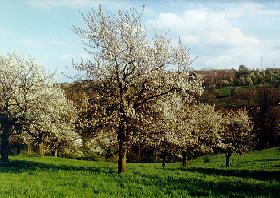| Nature Conservation
Dresden |
cultural habitats
|

Meadow with flowering fruit-trees. Such cultural
habitats as well as many varieties of cultivated plants and breeds of
domesticated animals developed long time ago are now threatened because
they are considered to be no more economically efficient. However they
should be protected because they contain a large genetic potential.
Further examples of cultural habitats are extensively
used grasslands and heaths representing valuable ecological communities
with native species as well as those immigrated many hundred years ago,
but also artificial ponds and residual waters of mining, replacing natural
standing waters that have been destroyed by man.
|
Nature Conservation Dresden will acquire cultural habitats to
cultivate and protect them because they shelter endangered communities of
animals and plants and they contribute to a coherent ecological
network.
|

